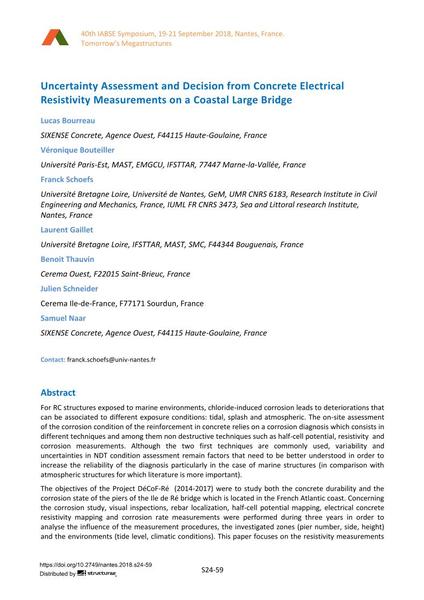Uncertainty Assessment and Decision from Concrete Electrical Resistivity Measurements on a Coastal Large Bridge

|
|
|||||||||||
Bibliografische Angaben
| Autor(en): |
Lucas Bourreau
(SIXENSE Concrete, Agence Ouest, F44115 Haute-Goulaine, France)
Véronique Bouteiller (Université Paris-Est, MAST, EMGCU, IFSTTAR, 77447 Marne-la-Vallée, France) Franck Schoefs (Université Bretagne Loire, Université de Nantes, GeM, UMR CNRS 6183, Research Institute in Civil Engineering and Mechanics, France, IUML FR CNRS 3473, Sea and Littoral research Institute, Nantes, France) Laurent Gaillet (Université Bretagne Loire, IFSTTAR, MAST, SMC, F44344 Bouguenais, France) Benoît Thauvin (Cerema Ouest, F22015 Saint-Brieuc, France) Julien Schneider (Cerema Ile-de-France, F77171 Sourdun, France) Samuel Naar (SIXENSE Concrete, Agence Ouest, F44115 Haute-Goulaine, France) |
||||
|---|---|---|---|---|---|
| Medium: | Tagungsbeitrag | ||||
| Sprache(n): | Englisch | ||||
| Tagung: | IABSE Symposium: Tomorrow’s Megastructures, Nantes, France, 19-21 September 2018 | ||||
| Veröffentlicht in: | IABSE Symposium Nantes 2018 | ||||
|
|||||
| Seite(n): | S24-59 | ||||
| Anzahl der Seiten (im PDF): | 6 | ||||
| DOI: | 10.2749/nantes.2018.s24-59 | ||||
| Abstrakt: |
For RC structures exposed to marine environments, chloride-induced corrosion leads to deteriorations that can be associated to different exposure conditions: tidal, splash and atmospheric. The on-site assessment of the corrosion condition of the reinforcement in concrete relies on a corrosion diagnosis which consists in different techniques and among them non destructive techniques such as half-cell potential, resistivity and corrosion measurements. Although the two first techniques are commonly used, variability and uncertainties in NDT condition assessment remain factors that need to be better understood in order to increase the reliability of the diagnosis particularly in the case of marine structures (in comparison with atmospheric structures for which literature is more important). The objectives of the Project DéCoF-Ré (2014-2017) were to study both the concrete durability and the corrosion state of the piers of the Ile de Ré bridge which is located in the French Atlantic coast. Concerning the corrosion study, visual inspections, rebar localization, half-cell potential mapping, electrical concrete resistivity mapping and corrosion rate measurements were performed during three years in order to analyse the influence of the measurement procedures, the investigated zones (pier number, side, height) and the environments (tide level, climatic conditions). This paper focuses on the resistivity measurements conducted with a four electrodes arrangement probe (Wenner type) on the piers of the Ile de Ré bridge using a vessel. Although resistivity values cannot directly provide an information on the passive/active state of the rebar because the measurement qualifies the electrical resistivity of the concrete cover (and not the resistivity of the steel/concrete interface which is usually obtained by Linear Polarisation Resistance measurements), it is a useful non destructive technique to point out the areas where the corrosion might be strongest. The purpose of this paper is to outline the errors made while measuring the resistivity given the uncertainty assessment based on both (i) the repeatability tests and (ii) the material local anisotropy and measurement's variability. Moreover, a model based on the evaluation of Probability of Wrong Assessment is proposed to help the owner of the bridge in taking a decision. |
||||
| Stichwörter: |
Brücke Stahlbeton Unsicherheit
|
||||
